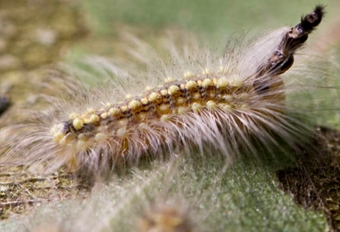PESTS AND DISEASES OF FORESTRY IN NEW ZEALAND
Seven questions about eucalypt pest gumleaf skeletoniser
Scion is the leading provider of forest-related knowledge in New Zealand
Formerly known as the Forest Research Institute, Scion has been a leader in research relating to forest health for over 50 years. The Rotorua-based Crown Research Institute continues to provide science that will protect all forests from damage caused by insect pests, pathogens and weeds. The information presented below arises from these research activities.
From Forest Health News 252, November/December 2014.

Gumleaf skeletoniser is an Australian caterpillar (Uraba lugens) from the Nolidae family that causes damage mainly to gum (Eucalyptus) trees by eating the foliage. Caterpillars grow quickly and “skeletonise” gum leaves by eating the green parts of the leaves and avoiding the veins. Older larvae are capable of eating entire leaves.
Which species of tree does it or could it affect?
Gumleaf skeletoniser caterpillars have an appetite for many eucalypt species, and will try and feed on whatever tree the mother moth lays her eggs on, and this can include unusual ones from time to time like silver birch and copper beech! In NZ it is often seen on E. nicholii, E. cinerea, E. globulus and Lophostemon confertus in urban areas. It can be found on native trees when they are growing in very close proximity to eucalypts, but damage is usually not significant. In Australia gumleaf skeletoniser is a well-known outbreak species, which means that occasionally the population can explode causing damage of plague-like proportions to natural forests. Sometimes areas as large as 150,000 ha have been affected. Outbreaks in Australia have occurred in forests dominated by E. marginata (Western Australia), and E. camaldulensis (New South Wales and Victoria). Occasionally severe impacts have been observed in young plantations, such as E . fastigata in New South Wales, or E. nitens in Tasmania.
It is unknown whether outbreaks will ever occur in New Zealand, but if they did then tree growth may be affected, extending rotation times. Low levels of defoliation from time to time are unlikely to affect eucalypt trees, which are remarkably hardy.
How can I recognize it?

Caterpillars are hairy and coloured pale yellow with black and grey markings. The young larvae are very small, less than 1 mm in length. Older caterpillars are characterized with a distinctive black “hat” on their heads formed by shed former head capsules. Mature caterpillars generally reach a length of 20-25 mm. Other life stages are rarely seen. Cocoons are usually hidden under bark or in leaf litter. Moths are nocturnal and survive for about a week. They do not feed. Eggs are laid in groups of 100 to 200 in neat, parallel rows on young leaves.
Are there other concerns related to gumleaf skeletoniser?
Exposure to the hairs of the caterpillars and their shed skins may cause an itchy raised rash on human skin referred to as contact dermatitis. The rash will repeatedly appear over many weeks and will require medical treatment. For this reason people handling infested plants or entering badly infested woodlots should wear protective clothing.
How did it get into New Zealand?
No-one is sure how gumleaf skeletoniser got into New Zealand but it was first found on trees on a Mount Maunganui golf course in 1992, a clue perhaps to an accidental human-mediated introduction. This first New Zealand incursion was recognised as posing a serious risk and initiated a dedicated management programme. The species was considered eradicated from Mount Maunganui in the late 1990s, but it was later discovered in Auckland in 2001. That population was too widely established for an eradication campaign to be effective, and the gumleaf skeletoniser has since spread to other regions (see distribution map in FH News, issue 251).
How far could it spread?
Climate models predict gumleaf skeletoniser has the potential to eventually spread throughout New Zealand apart from alpine areas above 600 m, areas of high rainfall on the west coast of the South Island, and cold, dry areas in Central Otago.
What can I do to reduce spread from the affected areas?
It is not economically feasible to try and reduce the spread of the gumleaf skeletoniser, however Scion was given permission to release a specialist natural enemy, a parasitoid named Cotesia urabae in 2010, following extensive safety testing. Scion is now undertaking mass releases of the parasitoid into areas where gumleaf skeletoniser has become abundant. It is hoped the parasitoid will assist with suppressing population growth of this pest.
Toni Withers and Nicolas Meurisse (Forest Protection, Scion)
This information is intended for general interest only. It is not intended to be a substitute for specific specialist advice on any matter and should not be relied on for that purpose. Scion will not be liable for any direct, indirect, incidental, special, consequential or exemplary damages, loss of profits, or any other intangible losses that result from using the information provided on this site.
(Scion is the trading name of the New Zealand Forest Research Institute Limited.)

 Farm Forestry New Zealand
Farm Forestry New Zealand

